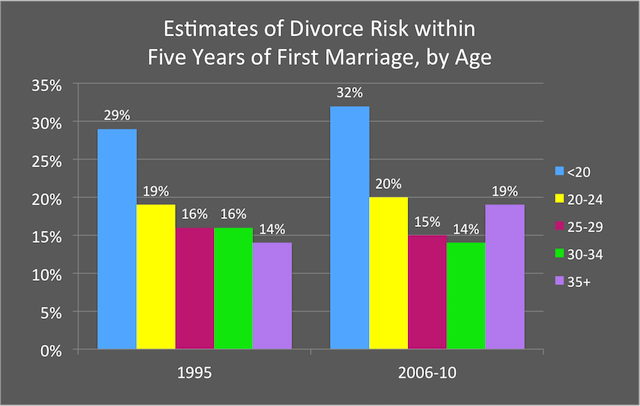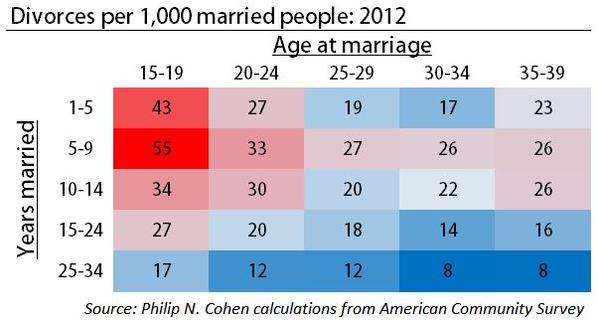In Wolfinger (2003), I analyze data from the 1987-88 National Survey of Families and Households. Controlling for family structure of origin, spousal family structure of origin, respondent sex, and the century month of the marriage, I use a piecewise linear spline to model the effects of age at marriage on divorce rates for first marriages. I used non-parametric techniques to determine this parameterization. The spline has two segments with a knot at age 23. Each year of age under 23 decreases the odds of divorce by 14 percent. At age 23, each year of age decreases the odds of divorce by 8 percent.
For updated results, I looked at first marriages in the National Survey of Family Growth (2006-2010) using Cox proportional hazards models.
A zero-order model with a linear term for age at marriage shows a 7 percent reduction in the odds of divorce for each year of age (N = 9,269).
This result persists after controlling for race, intact parentage, age at the time of the survey, size of metropolitan area, and sex (N = 9,269). Note that inclusion of age effectively controls for marriage cohort given the high correlation between these variables. The NSFG respondents were married between 1976 and 2009.
It goes to 8 percent after controlling for same, plus education, religious tradition, attendance, and sexual history (N = 9,110). Since the NSFG is a cross-sectional survey, these results should be interpreted with caution.
It turns out that a linear term doesn’t properly capture the effects of age at marriage. To determine the functional form of the marriage age-divorce relationship, I tested a series of models with piecewise linear splines (A quadratic also fit the data, although not as well.) The best fitting model had a two-piece spline with a knot at age 28. This model showed that each year of age prior to 28 reduces the odds of divorce by 11 percent. However, past 28 the odds of divorce increase by 5 percent per year. The change in slopes at age 28 is statistically significant. These results were confirmed with a series of generalized additive models (Hastie and Tibshirani 1990), which permit fully nonparametric estimation for continuous variables like marriage age. These models reveal that the effects of marriage age on divorce risk significantly departs from linearity. A quadratic term also fit the data well. My post in the Family Studies blog displays the results of the GAM; the predicted probabilities are from the spline model.
Here are predicted probabilities by age, based on the spline model (the GAM results look the same):
This result was virtually unchanged after including all of the aforementioned controls.
As is apparent from the above figure, a handful of respondents married at age 12 or 13. These outliers have no effect on the broader findings.
The median respondent in this sample married in 1998. I divided the sample into two groups based on this median. The curvilinear relationship between age at marriage and divorce risk only applies for people married since 1998. For earlier cohorts, the pattern I describe in Wolfinger (2003) persists: marrying later produces incremental declines in the odds of divorce.
Life tables also confirm the result. Here are five-year failure probabilities from the full NSFG 1995 and 2006-2010 NSFG samples:
And here are data courtesy of Phil Cohen from the American Community Survey which show the same finding:
In sum:
Youthful marriage makes divorce more likely. However, divorce rates go up past the early 30s (but still don’t reach the high divorce rate for very young spouses). This would appear to be a recent development, given that I obtained different results based both on data from 1987 and 1988 in my earlier work, and an analysis of earlier marriage cohorts in the new data from the National Survey of Family Growth. Analyses of recent marriage cohorts that constrain the effects of marriage age to linearity therefore produce incorrect and misleading results.
UPDATE: I replicated the findings presented here in a subsequent blog post for IFS using newer data from the 2011-2013 NSFG,
References
Hastie, T. J. and R. J. Tibshirani. 1990. Generalized Additive Models. London: Chapman & Hall.




Thats was a really interesting read!! Also, I didn’t know you had a blog, thats so cool!
Well I guess people shouldn’t get married till after 30 or something. Still a good blog post, thanks for sharing!
Love, Iris
Pingback: Want to avoid divorce? Wait to get married — but not too long—says U researcher | UNews
It is an interesting correlational study, but drawing a causal interpretation seems hasty without controlling for education, family income, occupation. Given your data points, a more conservative conclusion would be merited.
ShSims:
I did control for education, and it made no difference. Moreover, it’s pretty clear that age at marriage is having some effect on divorce… it’s a well known relationship. As to causality, I have no idea. I said as much in the Family Studies blog post.
Nick Wolfinger
Pingback: Getting Married Past This Age Increases Your Risk Of Divorce, Research Suggests | Slantpoint Democrat
Pingback: Getting Married Past This Age Increases Your Risk Of Divorce, Research Suggests | Interesting News From World
Pingback: Getting Married Past This Age Increases Your Risk Of Divorce, Research Suggests | Slantpoint
Pingback: Getting Married Past This Age Increases Your Risk Of Divorce, Research Suggests - Democratsnewz
Pingback: Getting Married Past This Age Increases Your Risk Of Divorce, Research Suggests | News Agency
Pingback: Getting Married Past This Age Increases Your Risk Of Divorce, Research Suggests – Hot Topix Now
Pingback: Getting Married Past This Age Increases Your Risk Of Divorce, Research Suggests | Pride & Equality Post
Pingback: Getting Married Past This Age Increases Your Risk Of Divorce, Research Suggests | Information From World
Pingback: Getting Married Past This Age Increases Your Risk Of Divorce, Research SuggestsNews4world | News4world
Pingback: Getting Married Past This Age Increases Your Risk Of Divorce, Research Suggests
Pingback: Getting Married Past This Age Increases Your Risk Of Divorce, Research Suggests | News Agency
Pingback: Want to avoid divorce? Wait to get married — but not too long - Technology Org
Pingback: Getting Married Past This Age Increases Your Risk Of Divorce, Research Suggests | Interesting News
Thanks for the interesting information! I wonder have you considered whether the increase in divorce for those 35+ could also, in part, result from marrying someone who was already married once before? You speak in terms of first marriages, but some of those 35+ are surely marrying someone who was married once before. This can certainly increase the level of stress on the relationship, particularly if there is a child from the previous marriage/constant interaction with the ex. I know there isn’t much data that explores someone on their first marriage marrying someone who is on their second marriage. Seems like a place worthy of exploration.
Heidi:
It’s limited to first marriages, for the very reasons you suggest.
Nick
Pingback: Want to avoid divorce? Wait to get married — but not too long | InspireTechno.com
Pingback: Venturuso - Hispanic Venture Capital News
Pingback: Sposarsi dopo i 30 anni aumenta il rischio di divorzio: "L’età giusta per il matrimonio è tra i 25 e 32 anni" (FOTO)
Pingback: ¿Quiere evitar divorciarse? Espere un poco pero no demasiado, afirma una investigación - Actualidad en Psicología
Pingback: Math Says This Is the Perfect Age to Get Married
I come to know this research today as TIME has forwarded the related article on Facebook today.
One question is about interpretation. There are many reasons for those who married beyond mid-30 to have a higher rate of divorce. If we interpret it as a causal effect, we may want to manipulate our marriage age so that it has to be finished before mid-30s. But this somehow sounds ridiculous, as there are a lot of frictions in meeting the right mate and different people meet the one at very different ages. If we meet the right one late, there is no point to hurry to get married early to meet this age range.
For economists, we may suspect that there is a large part of effect due to so-called “selection”. This may include those who have stronger (unobserved) preference for marriage (or psychological gain from marriage) may try to find their mate earlier and decide to marry earlier and not as likely to get divorced, as long as they have spent their early to mid-20s in exploring their life path and build up their financial security. However, those who have weaker preference on marriage may just search for their mates later, get married later and are also more likely to divorce because they care less about marriage. These effects does not seem to be a direct causal effect to me, and thus the first paragraph of the TIME article is somewhat misleading. Note that preference is unobserved, so controlling social-economic background does not remove its effect.
A partial exception is the argument that those who search later may find it harder to get a good match due to a small pool of single people. Then it may be a better choice for an individual to search for mates earlier given others’ behavior unchanged. But still, if most people delay the search, it shouldn’t be a matter.
Is “decreases” a typo in: “Each year of age under 23 decreases the odds of divorce by 14 percent.”? This one sentence seems to contradict your findings.
Yep, looks like a typo to me 😉
Pingback: Omens of divorce that the majority does not give importance, but they should do so - Coolest Hacks
This is a really interesting piece, fascinating findings. I got married young and then divorced before I was 30 so I guess there is some truth in what this data is telling us. There is in my case anyway. Not one size fits all, but I guess you are a bit more mature by the time you’re 30. You live and learn!
Reasons for not changing your married name after divorce vary, such as maintaining your professional identity. Legally, the choice is yours alone to make.